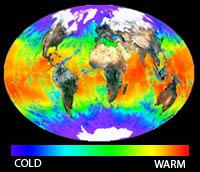Temperature Transformations
Cold mornings seem to make everything slower, from getting out of bed, to tying your shoes. This is true when we look outside as well. Many animals are not active when it is cold outside, and if you are lucky enough to find a lizard or insect under a rock when it is cold outside, often times they can only move very slowly.
When we look at our bodies on a miniature scale, down into the reactions that occur in our cells, we find that cold temperatures are linked to slower movement. Temperature is a measure of how fast molecules are moving, and slower (colder) molecules make for slower reactions.
Humans are endotherms (commonly called “warm-blooded”), which means they create their own body heat, so in most cases, you can’t blame your laziness on the cold. But for ectotherms (“cold-blooded”) that don’t create their own body heat, the temperature of the surroundings can affect their activity. So when a lizard is moving slowly in the cold, it is due to its muscle cells being unable to work faster.

Reptiles, such as this lizard, are "cold-blooded" and cannot create their own body heat.
Movement is not the only body function that can change with the temperature. Digestion is another good example. Lizards will move back and forth between the sun and shade to keep their bodies around a certain temperature. For most lizards, this temperature is best for digestion, or the processing of food. If they get too cold, they cannot digest food as well, and cannot get as much energy and nutrients out of their meal.
Growth is also affected by temperature in some organisms. Tissues in the bodies of these organisms may grow faster or slower if the organism is held under different temperatures. How do you think temperature affects growth? Will an animal grow faster or slower under warmer temperatures?
To answer this question, let’s see what Manduca has to teach us about growth under different temperatures.
Sizing Up Growth
You may have heard that your adult body size depends on a few different things, such as the amount and quality of the food you eat, or what size your parents are. But what if temperature could affect how large an animal grows? What if, by being warmer or colder while growing, we could maximize growth and create larger adults? While we cannot produce hulking humans using temperature, we can produce larger or smaller insects.
However, temperature also affects growth by changing the length of the growing period. If we think about an animal that grows at the same rate, or adds the same amount of tissue to its body every day, then by increasing the number of days it can grow, it will end up larger. On the other hand, if we decrease the days of growth, it will end up smaller.
But how do lower or higher temperatures change the length of time that some organisms will grow, thereby changing how big they end up? Maybe Manduca can teach us a thing or two about how temperature affects the length of the growing period.
View Citation
Bibliographic details:
- Article: Temperature Transforms Tissues
- Author(s): Dr. Biology
- Publisher: Arizona State University School of Life Sciences Ask A Biologist
- Site name: ASU - Ask A Biologist
- Date published: December 28, 2016
- Date accessed: April 17, 2024
- Link: https://askabiologist.asu.edu/manduca/temperature-transformations
APA Style
Dr. Biology. (2016, December 28). Temperature Transforms Tissues. ASU - Ask A Biologist. Retrieved April 17, 2024 from https://askabiologist.asu.edu/manduca/temperature-transformations
Chicago Manual of Style
Dr. Biology. "Temperature Transforms Tissues". ASU - Ask A Biologist. 28 December, 2016. https://askabiologist.asu.edu/manduca/temperature-transformations
Dr. Biology. "Temperature Transforms Tissues". ASU - Ask A Biologist. 28 Dec 2016. ASU - Ask A Biologist, Web. 17 Apr 2024. https://askabiologist.asu.edu/manduca/temperature-transformations
MLA 2017 Style

Map of the Earth showing surface temperatures. (NASA/Wikimedia)
Be Part of
Ask A Biologist
By volunteering, or simply sending us feedback on the site. Scientists, teachers, writers, illustrators, and translators are all important to the program. If you are interested in helping with the website we have a Volunteers page to get the process started.








